Rowing Against the Wind
For many, the road to writing a master’s thesis is challenging and often filled with minefields. Now, imagine what it is like to write your first major publishable-quality academic paper in a language other than your native language. This will give you a sense as to the pathway Yuehua Zhu encountered on her way to defending her master’s thesis last week.
Yeuhua took my Research in Education class a year ago and, after learning about the magic of educational research, decided to pursue a master’s thesis. This was not easy for her. She gave it a great deal of thought and, in the end, began her journey. But she was rowing against the wind!
She used all of the support that was available, including weekly meetings with me and frequent visits to the Leddy Library Writing Support Desk. She also asked for feedback from her student colleagues, which helped a great deal.
Two of the members of Yuehua’s thesis committee were also of great help to her. Drs. Ma and Zhou provided wonderful advice to her on directions her research might go to achieve her stated purposes.
Yeuhua Zhu has completed a thesis which fills an important gap in the research literature by showing how student political participation impacts social integration, student sense of belonging, and English proficiency; all of which contribute to Chinese-origin student retention and success at Canadian post-secondary institutions.
Look for her thesis, “Enhancing Social Integration in Canadian Post-Secondary Educational Institutions for Students of Chinese-Origin through Political Participation.” It is outstanding.

Dr. Clayton Smith, Dr. George Zhou, and Dr. Zhenzhong Ma
-Clayton Smith
Using Personas to Enhance Understanding of International Student Learning
At this week’s UWindsor GATAcademy, I had the pleasure of presenting a workshop on “Connecting Best Practices for Teaching Linguistically-Diverse International Students with International Student Satisfaction.” While we presented some of the findings from our recent research on this topic, we did it with a bit of a student spin, which made it fascinating to present.
First, let me acknowledge the work of two students. Miranda Pecoraro, an Outstanding Scholar and 3rd year Social Work student, and Renan Paulino, a MITACS intern from Brazil. They took our research and developed it into a game that permitted participants to engage in both constructivism and experiential learning as they learned about ways we can enhance the teaching and learning of international students. This was the first time we tried it, and from all reports, it went well.
I would also like to commend three other students who served on our expert panel for the game. These students included Victor Sam (Computer Science, Ghana), Sumeet Kaur (Bachelor of Arts-Criminology, India), and Ahuying Zhuo (Law, China). And, of course, our international student advisor, Deena Wang, who was instrumental in organizing the day.
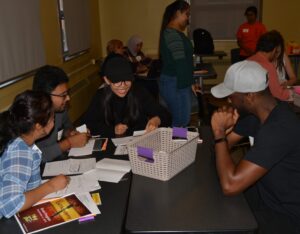
What we did was to build 5 personas representing international students at the University of Windsor and then provide the related teaching practices for each persona to a groups of participants. Each group was asked to select 10 practices (they were given an average of 20 to select from) they thought fit the assigned persona and then defend one of these to the wider group. The expert panel, using green (agree), red (disagree), and yellow (not sure) lollipop signs helped us understand how each teaching practice may or may not be appropriate for the persona. It was a wonderful display of constructivism and experiential learning.
In the end, the GAs and TAs came away from the workshop with a key point. As we approach our students, we need to learn enough about each student to determine what teaching practice will enhance learning, both inside and outside of the classroom. Factors such as country of origin, area of study, length of time studying abroad, and level of study all lead to better understanding of the learning preferences of international students.
This was fun!
-Clayton Smith

Taking My Breath Away!
Throughout the summer, it has been my pleasure to enjoy working with two wonderful undergraduate students, Miranda Pecoraro and Renan Paulino. Each contributed in meaningful ways to our ongoing research projects that are examining student views on the promising practices for teaching linguistically and culturally diverse post-secondary international students.
Miranda Pecoraro is a third-year Social Work student from Windsor, Ontario who is in our Outstanding Scholars program. She has been working with me for the past three semesters. The Outstanding Scholars program “provides an exceptional and supportive undergraduate learning experience for high-achieving students, emphasizing depth and breadth of research-based academic inquiry, strong and ongoing faculty/student mentorship, effective communication of research achievement, and achievement of external recognition of academic excellence.” Check out this video where Outstanding Scholar students explain the OS program in their own words.
Renan Paulino is a third-year Education student from Brazil who joined us as part of the Mitacs Globalink Research Internship program, which places undergraduate students at Canadian universities from a wide variety of countries (e.g., Brazil, China, European Union, Germany, India, Israel, Mexico, UK, US) to engage in faculty-led research projects. The focus of the Mitacs program is to create awareness of the leading research being done at Canadian universities and to enhance linkages between top international students and Canadian university faculty members. Here is a video on the Mitacs Canada Globalink Research Internship program. Interestingly, this is Renan’s second international exchange in Canada (the first was in St. Johns, Newfoundland while he was a high school exchange student), and he is considering returning for graduate education in the near future…hopefully with us!
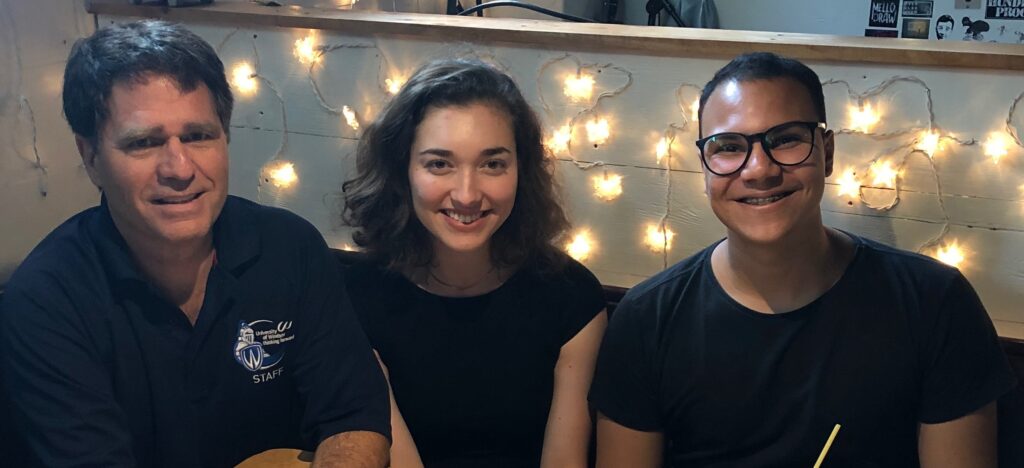
Miranda Pecoraro and Renan Paulino
Undergraduate research is one of the “high-impact practices,” originally identified by George Kuh (2008), that can be life-changing. They “demand considerable time and effort, facilitate learning outside of the classroom, require meaningful interactions with faculty and students, encourage collaboration with diverse others, and provide frequent and substantial feedback.” Students who participate in high-impact practices experience a more complete university student experience. Those that engage in undergraduate research frequently develop strong relationships with student peers and faculty members.
Our students participated in writing projects that led to a peer-reviewed published book chapter and research poster, and a journal article in press on the topic of “Variability by Individual Student Characteristics of Student Satisfaction with Promising International Student Teaching Practices.” They also developed a workshop on this topic for our upcoming University of Windsor GATAcademy. Further, they are facilitating an international student-learning community project that is continuing to investigate the difference in student opinions between STEM (Science, Technology, Engineering, and Mathematics) and non-STEM students on this topic.
They really take my breath away!
I cannot wait to welcome more undergraduate students into our research group!
Clayton Smith
References:
Kuh, G. D. (2008). High-impact practices: What they are, who has access to them, and why they matter. Washington, DC: Association of American Colleges and Universities.
Smith, C., Zhou, G., Potter, M., & Wang, D. (2019). Connecting best practices for teaching linguistically and culturally diverse international students with international student satisfaction and student perceptions of learning. In James, W. B., & Cobonoglu, C. (Eds.), Advances in Global Education and Research Volume 3, (252-265). Sarasota, FL: Association of North America Higher Education International. https://scholar.uwindsor.ca/educationpub/24/
Smith, C., Zhou, G., Potter, M., & Wang, D. (2019). Connecting best practices for teaching linguistically and culturally diverse international students with international student satisfaction and student perceptions of learning. Poster presented at the Society for Teaching and Learning in Higher Education Conference, Winnipeg, MB.
Mentors and Messes
While attending the American Association of Collegiate Registrars and Admissions Officers’ (AACRAO) Technology and Transfer Conference in Las Vegas this week, I dropped into a roundtable discussion called “Mentors and Messes” that was a follow-up to an earlier session in which Helen Garrett (University of Washington), Shweta Kadam (University of Nevada Las Vegas), and Christine Paal (Boston University) shared the top ten leadership lessons learned by women in technology.
Women technology professionals, many of them technology leaders on their own college and university campuses, attended this session. Others were relatively new to the profession. Each had a story to tell and share with their colleagues from across the country.
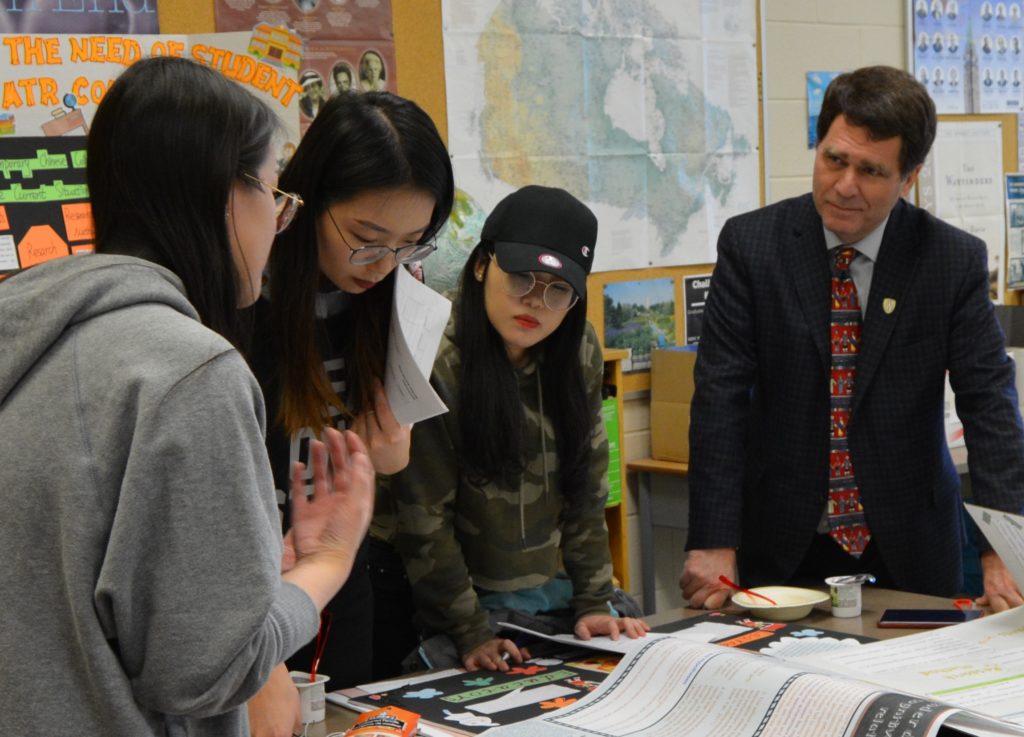
After decades of work in higher education trying to bridge gender equity, I was amazed by what I heard.
How can it be that we have made such little progress on this critically important issue?
We talk a lot about gender equity. Sometimes it is about salary. Sometimes it is about opportunity to advance in our field of choice. What I do not understand, however, is how we can still be facing some of the same challenges that confronted higher education a generation or two before us.
The theme of the discussion was mentorship. That we should each look to each other and to men who support gender equity to find ways of getting a fair salary, to receive a meritorious promotion, and to ensure that women’s voices are heard at all levels of the academy.
While I am an advocate for mentorship anywhere and everywhere, I guess I am thinking that we need to do more.
While attending this session, I reflected on a frustration I feel every day as a professor. In my classes, I work hard to make sure that all of my students are encouraged and supported so that they can achieve their potential whatever that might be. This goes for students from other cultures, those with disabilities, Indigenous learners, and all the other types of students that grace my classroom. This includes women who are preparing to become tomorrow’s faculty members and educational leaders at all types of learning organizations. I remain perplexed that they will face a world where gender equity may limit what they can achieve throughout their careers.
I further reflected with this impressive group of women technology leaders that I was blessed by a wonderful female mentor when I first began my career in higher education. Mary Elisabeth Randall was our associate vice-president for enrollment services who served as my boss when I was director of admissions at a small public university in Maine, the University of Maine at Augusta. As it turns out, she was also the sitting president of AACRAO. Mary Elisabeth encouraged me to become involved in AACRAO and to pursue my doctorate in higher education, both of which I did and that laid the foundation for my career journey. I will always remember her strength of character and her belief in me. It led me to think often about what women can and should achieve in our educational world.
So I encouraged those in attendance at this session to consider mentoring not only women, but also men. The power and example of mentoring can and does make a big difference in all of our lives.
I will continue to think about what else I can do to further gender equity in all parts of my life.
Clayton Smith
Playing Your Position
While attending the Society for Teaching and Learning in Higher Education Conference recently, I attended a session in which Melanie Hamilton and Bonnie Farries, from Lethbridge College, spoke about the intersection of Scholarship of Teaching and Learning (SoTL) and Strategic Enrolment Management (SEM).
These are two areas that rarely find their way to the same platform, either at a professional or an academic gathering.
Hamilton and Farries introduced a model to show how each of these desparate activities support overall student and institutional success. The model they shared at the conference is below. Hamilton and Farries argued that SEM focuses on macro level decision-making without sufficient attention to the micro level and SoTL focuses on the micro level with little attention paid to macro level priorities. Through effective coordination, SEM and SoTL can enhance macro and micro activities to achieve greater levels of student success.
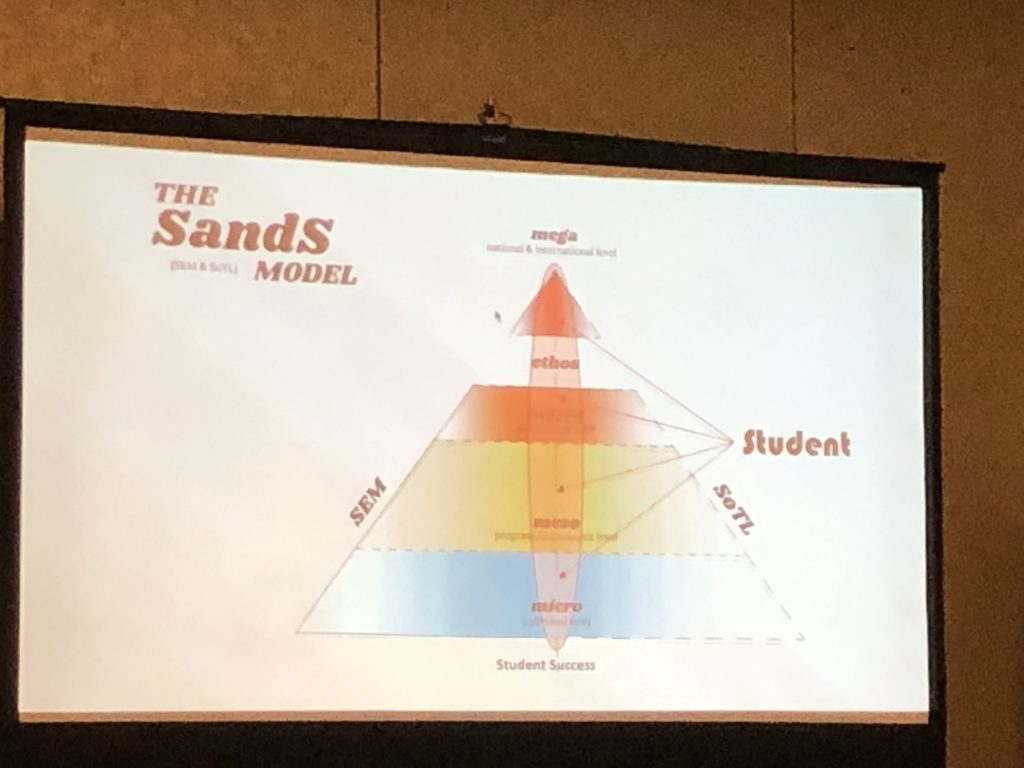
My take away is that both SoTL and SEM play an important and effective role in institutional effectiveness and student success.
The maxim of “playing your position” seems appropo to the intersection between SEM and SoTL. Many have written about the importance of playing your position within the context of team. Vince Lombardi said, “Individual commitment to a group effort–that is what makes a team work, a company work, a society work, a civilization work.” Andrew Carnegie commented, “Teamwork is the ability to work together toward a common vision. The ability to direct individual accomplishments toward organizational objectives. It is the fuel that allows common people to attain uncommon results.” And Helen Keller professed “Alone we can do so little, together we can do so much.” All could be said to endorse the notion of each of us playing our position well; that by performing our role effectively, we can achieve great things.
If enrolment professionals and the instructors who teach our classes each perform their respective roles well, it is likely that we will achieve much institutional and student success.
Clayton Smith
Ireland Take-Aways
While in Ireland last week, I became aware of the concept of “take-aways” rather than the North American term “to-go,” and so I thought I would reflect on a few take-aways from our recent, mostly sunny, trip to Ireland.
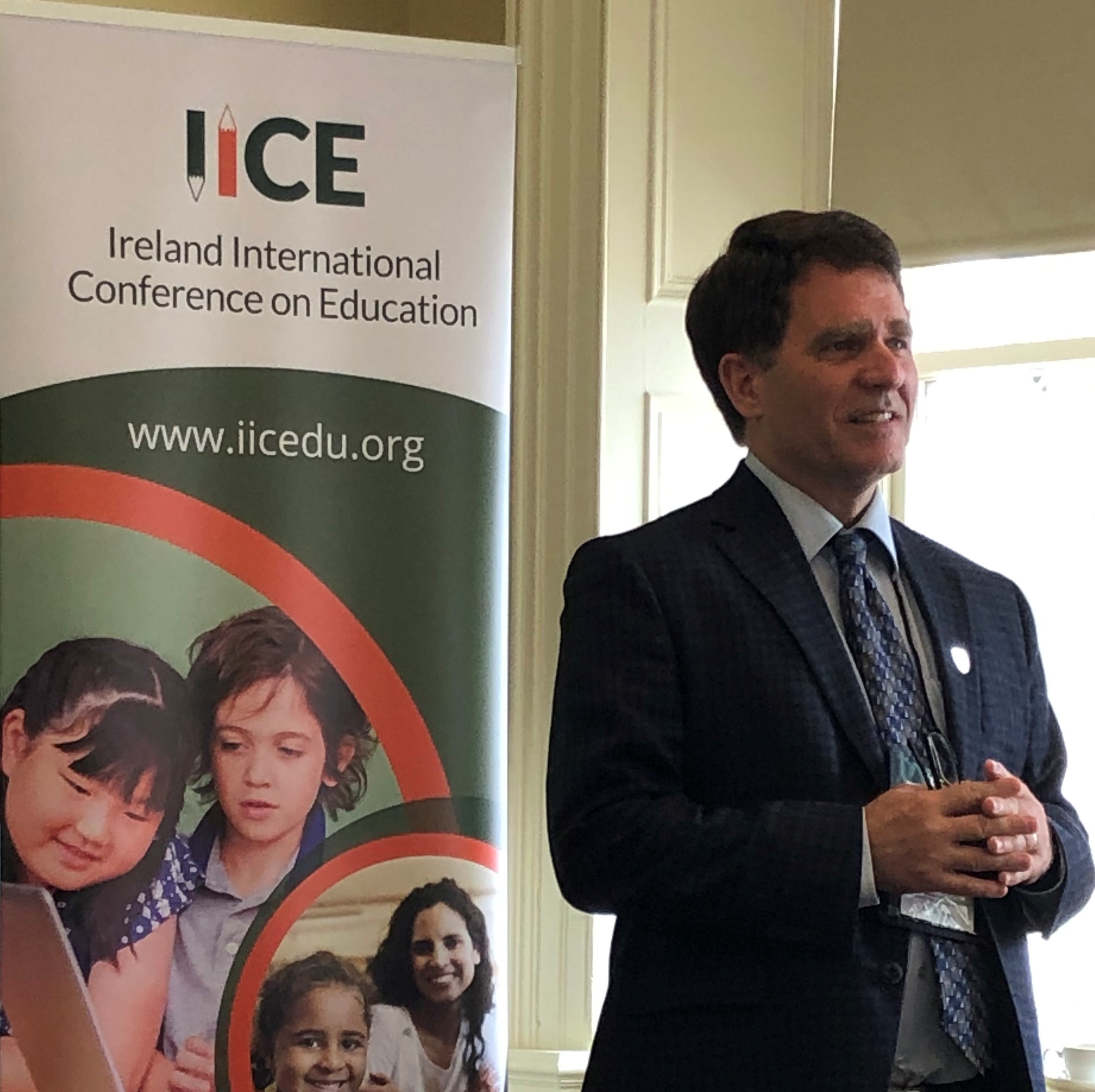
Let me start with my reason for visiting the emerald isle.
I had the pleasure of presenting a paper on some research my research team has recently completed on “Connecting Best Practices for Teaching Linguistically and Culturally-Diverse International Students with International Student Satisfaction and Student Perceptions of Learning” at the Ireland International Conference on Education, which was held in Dún Laoghaire, Ireland, a short distance from Dublin. It was well received and left me reflecting on how I might collaborate with researchers in other countries on this topic. So many are interested in learning more about how we might provide a student voice in our research on the practices for teaching international students.
This is a small conference (about 100 participants) that left me with a developing network of research colleagues from around the world–all with an interest in enhancing education within the post-secondary education sector. Here are a few highlights:
- Gabriel-Miro Muntean, from Dublin City University spoke about the EU Horizon 2020 NEWTON Project’s use of innovative technologies and enhanced learning methods and tools to create or inter-connect existing state-of-the-art teaching labs and to build a pan-European learning network platform to encourage more students to consider STEM careers. While only a few years in, it shows great potential for turning on a new generation or STEM scientists and practitioners.
- Michael Plummer, from MAPco Education Consultant Group, shared a bit about misguided public criticism of education, and special education in particular. Findings from his study revealed that there is a continuing lack of knowledge by the public on the issues around special education. He also said “You can teach about the profession, but you cannot teach someone how to be a teacher. Teaching is a complex art, and not everyone can do it.” Very powerful stuff. Really made me think about the individual characteristics that contribute to inspired teaching.
- Deborah Patterson and Susan Carlile, from Portland State University, intrigued us with a session called “Nags, Bitches and Beauties: Women in Leadership” in which they shared the challenges facing women leaders, and recommended development of formal and informal mentoring program, use of a network of support within and outside the organization, and increased training for allies. I have seen many of these challenges first hand, and was impressed with their body of research. Hopefully, it will lead to action in the academy to enhance the way we support women along the way to leadership roles.
- Adam Unwin, from University College London, spoke about some themes from his book with John Yandell, Rethinking Education: Whose Knowledge is it Anyway? In particular Unwin stressed the challenges associated with the impact of Neoliberal measurement approaches, which have done a lot to “deform the landscape of schooling” in the United Kingdom. It made me reflect on how we can address this approach as the Ontario Government pushes performance funding within the post-secondary sector in the next several years. He even gave me a copy of his book!
But you can’t just go to Ireland for work, so we also took in some of the sights.
We toured the Wicklow Mountains, otherwise known locally as the Dublin Mountains, which borders the counties of Dublin, Wexford, and Carlow. Of course, they really are not mountains. Our tour guide told us at 561 meters, they are not tall enough to be mountains. But are they ever beautiful and mountain-like!
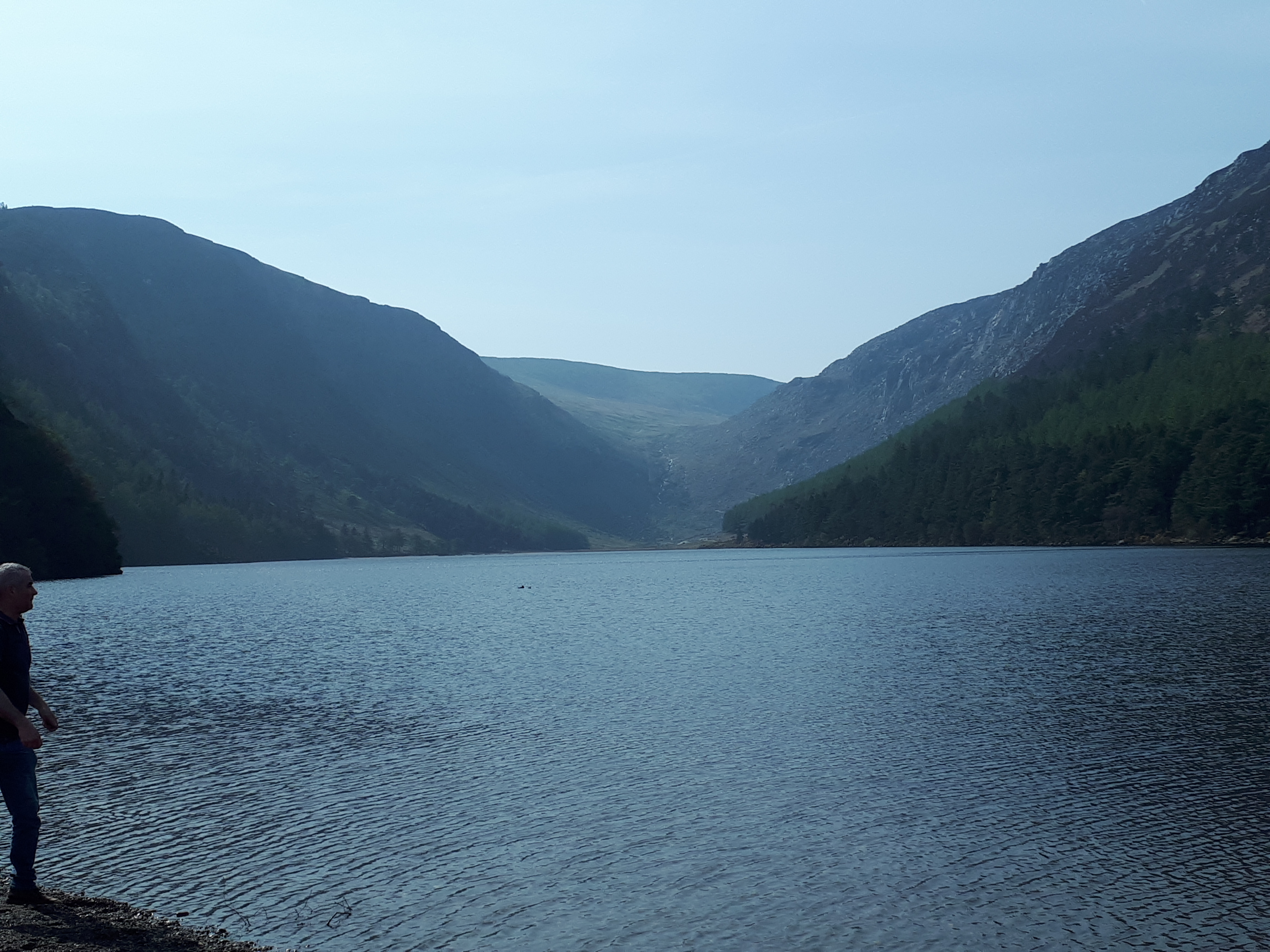
We also visited the western part of the country and took in side trips to Cliffs of Moher and the City of Galway. The Cliffs of Moher are really impressive. They stretch eight kilometers, reaching a height of 214 meters, with a vista embracing the Aran Islands. Almost thought I was in Newfoundland. The warm–we were told they are not always warm–winds whipping across the landscape took us back to the Harry Potter films, one of which was filmed here.

Galway is wonderful. Full of cultural charm, with lots of shopping and, of course, more restaurants and pubs than one can count.
Then there is Dublin itself. So much history with the experience of nationhood so near the surface of many conversations. Some of what tops the list include Dublin Castle, St. Patrick’s Cathedral, Christ Church, the National Museum of Ireland, St. Stephen’s Green, Trinity College, and the huge Phoenix Park that includes the Dublin Zoo, home to some very famous lions.
Our tour guides (two of the three were named John) used a wonderful style of speaking that I think I will try to use more in my teaching. Basically, they introduced what we would do, then told a story or two about what we would see, and then summarized before moving on to a new slice of the tour. Then, at the end, they shared some of the highlights. While it may be something that is just present in the Irish approach to interpersonal communications, it really worked, and was enjoyed by everyone.
Perhaps our true take-aways centre on the people, including the colleagues we met at the conference along with the native Irish we came to embrace through our travels in this breath-taking land.
I think we will be coming back.
Clayton Smith
Providing SEM Leadership in Times of Disruption
At this week’s Canadian Strategic Enrolment Management (SEM) Summit, we discussed SEM leadership in times of disruption. We focused on how changes in institutional leadership, governments, and technologies affect SEM performance. In particular, we discussed the impact of disruption on building community and international engagement.
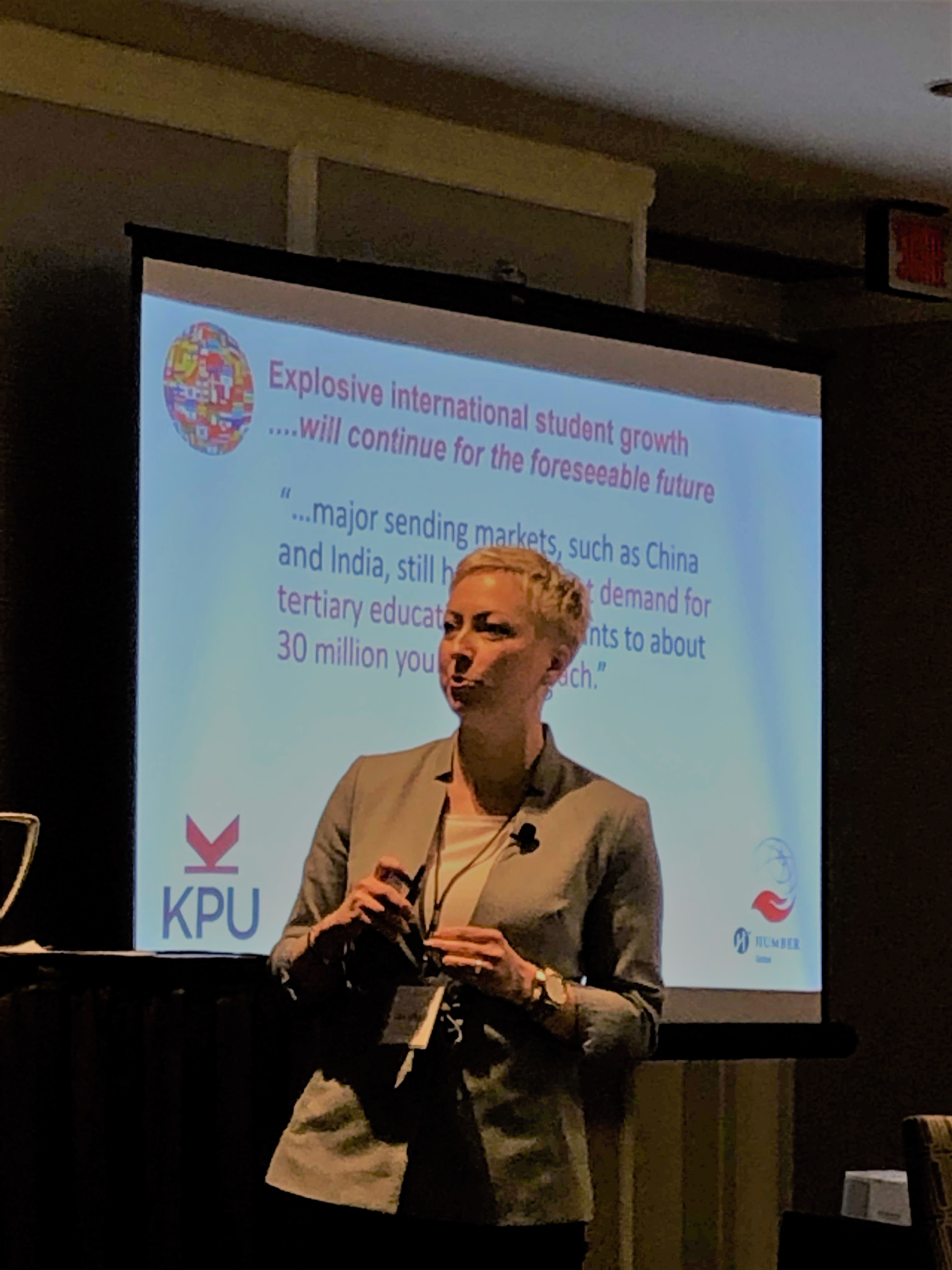
Some of our discussion points included:
- Who should be around the table when a disruption occurs? Are groups already formed, or is there a need to develop new groups?
- How do we get the data needed for decision-making? Some may already exist, but new data may also be needed.
- While disruption can leave us perplexed, we need to find ways to keep our sense of purpose while managing SEM during challenging and distracting times.
- Disruption can be an opportunity to try something new or to focus the institution more clearly on its educational values and aspirations.
- The growing challenge of maintaining data privacy and security in turbulent times.
- The opportunity disruption provides to move from competition to collaboration across the higher education sector.
For many, we are already in disruptive times in the area of international student enrolment and engagement. Some talked about the near explosion of international student enrolment in recent years, especially for students from India. We heard about how this challenge might be a way of bringing together budget and SEM; that sometimes disruption can be internal; that budget drives culture; and opportunities flow from effective brainstorming across institutional silos. We were reminded of the importance of supporting international students, both personally and academically, as they enrich our institutions.
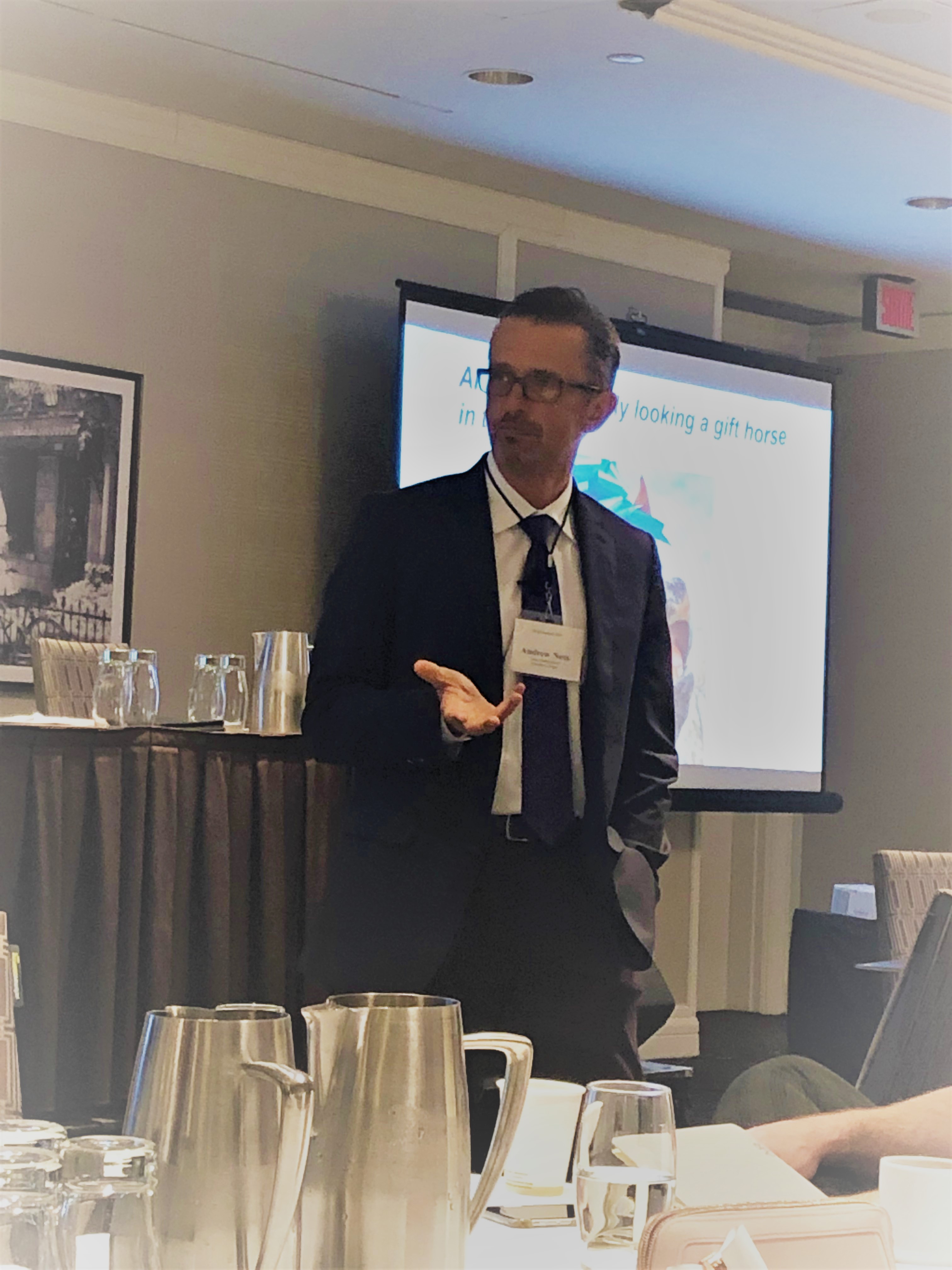
Jason Hunter, Vice President, Student and Community Engagement, at Humber Institute of Technology and Advanced Learning put it well when he said the Summit helped us “to frame critical issues” and “to build capacity” by developing a strong SEM network of administrators and educators across Canada. We all experienced a little SEM therapy.
For me the key take away is the importance of encouraging collaborative dialogue and planning for disruption as we work to enhance institutional health and student success through our SEM work.
Feeling renewed!
Clayton Smith
Crossing the Border
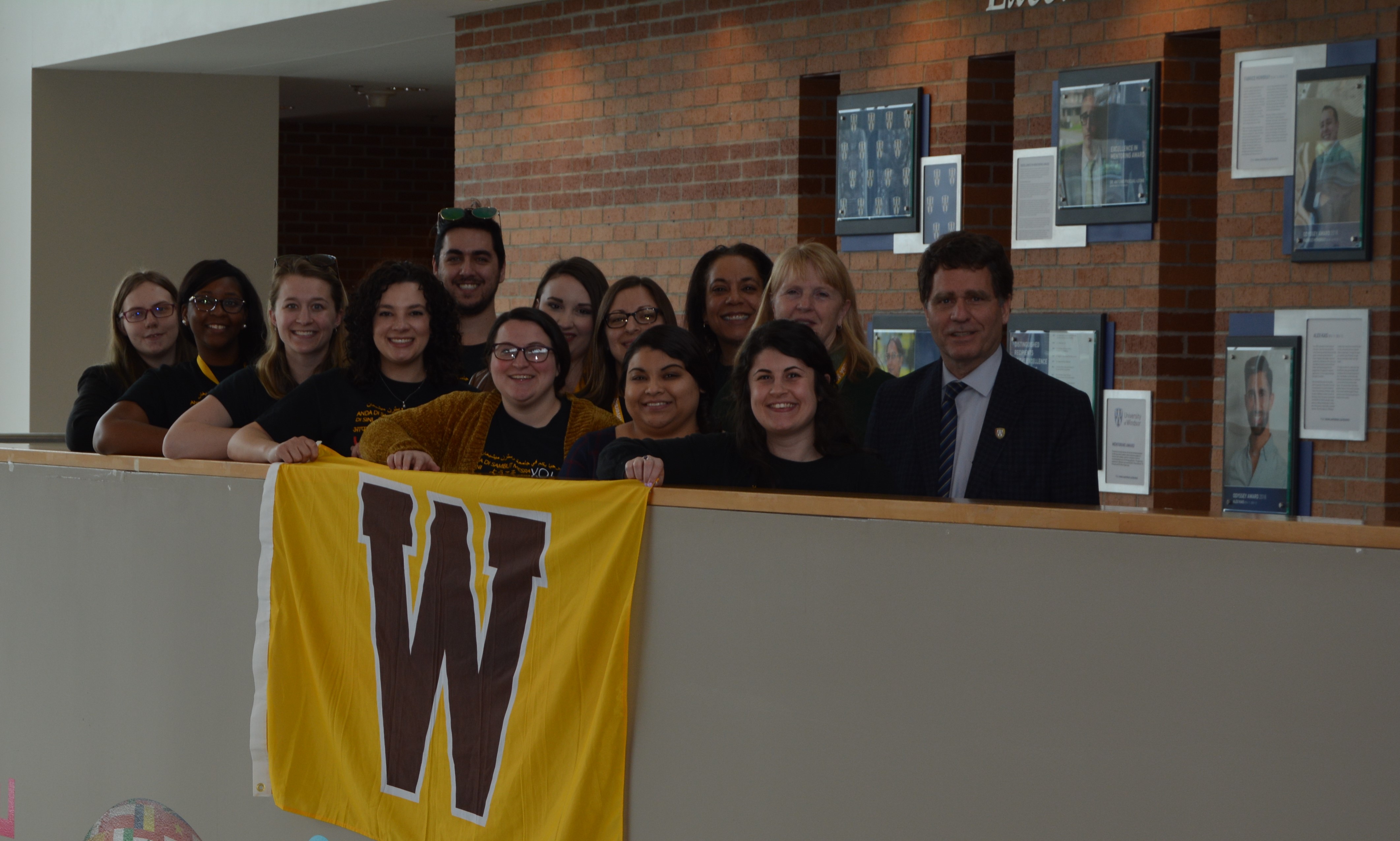
This week I, along with Windsor colleagues (Dr. Ken Montgomery, Dean, Faculty of Education; Ryan Flannagan, Associate Vice-President, Student Experience), welcomed graduate students and faculty to the University of Windsor from Western Michigan University’s Higher Education and Student Affairs Leadership program during their study abroad trip through Ontario. As a dual citizen (both US and Canadian), it was my pleasure to share a bit about Canadian higher education.
As Canadians often do, we opened our dialogue on the state of the weather, which was 9 degrees Celsius and with a forecast of light snow mixed with rain. Keep in mind this was April 10th! We then talked about geography. Some were surprised that they had traveled south as they came into Canada and that Windsor is the southern most part of Canada, with a good portion of the US north of us.
I was, of course, glad to see some adventurous students try poutine in our cafeteria, a made-for-students delicacy composed of fresh-cut french-fries topped with cheese curds and gravy. They loved it!
The visiting students and faculty were very interested in the similarities and differences between the educational systems and the challenges and opportunities facing the Canadian and Ontario higher education systems. This, of course, led to some discussion of the political system in Canada since higher education is mostly funded and controlled by the provinces.
Our conversation touched on many topics, but two were of particular interest: international education and student mental health.
On international education, we discussed the growing international student population on Canadian campuses, including the University of Windsor, and the stalled and declining enrolment of international students at many American colleges and universities.
Mental health for both American and Canadian institutions is a growing concern. Some were surprised to learn that mental health support at our campus is greater than it is in the community.
We then took a short tour of our student services, snapped a picture, and wished them well as they travelld to other Ontario colleges and universities.
My guess is they will head home with a richer understanding of Canadian higher education and a sense of some of the things we can do together in the years to come.
A pleasure!
Clayton Smith
Potluck, Posters, & Loads of Fun
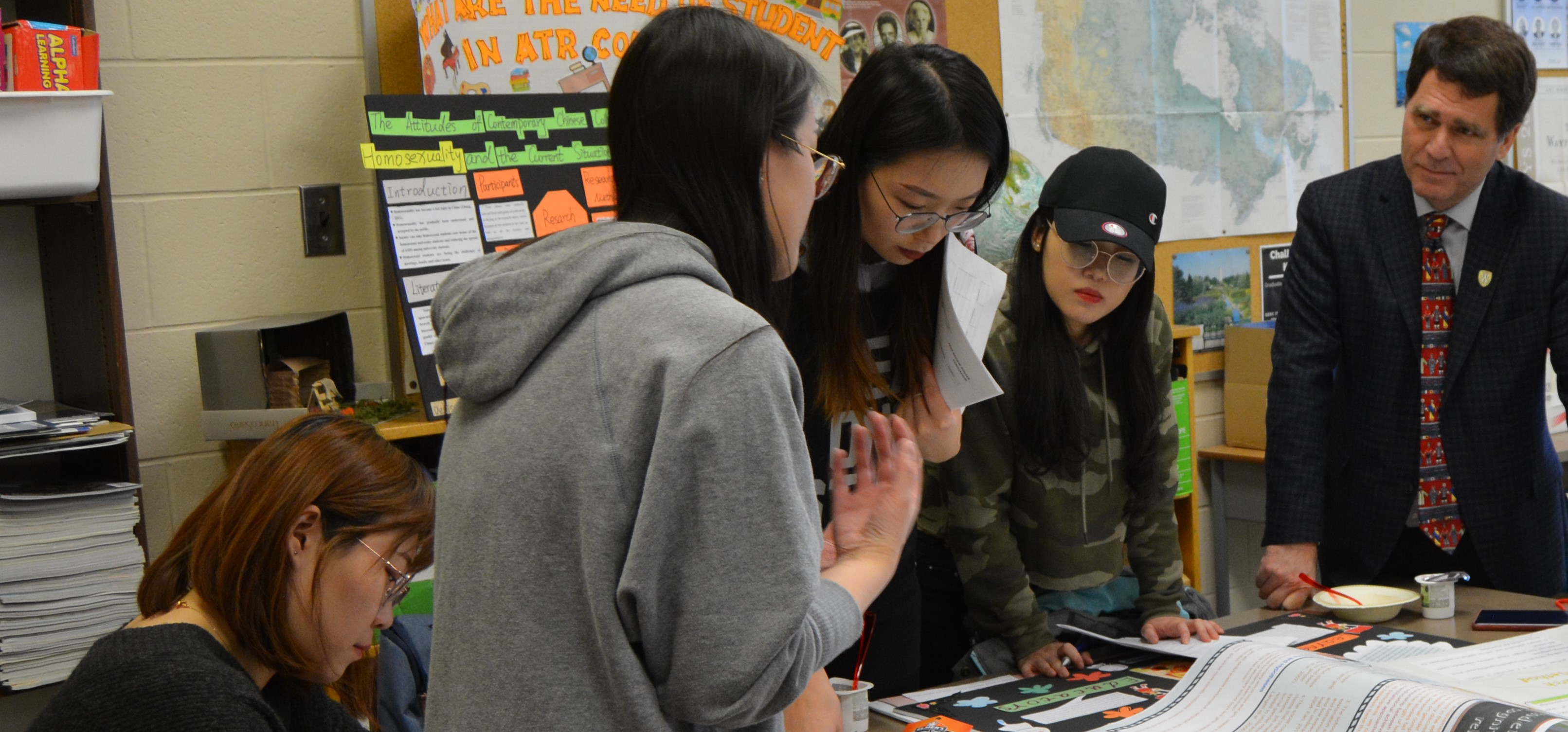
For the past few semesters, I have ended my smaller classes with potluck food and beverage sharing, a poster fair, and a chance to end the semester with loads of fun. I thought I’d share a bit about this in case this may be something other teachers might want to try.
The students plan the potluck. I just ask that they try to mix it up a bit so we don’t get all chips and poutine! This year students brought food items in from their home culture, as well as what could readily be found in nearby bakeries and grocery stores. What is important is that everyone contribute. The added benefit is that there is almost always food left over, and this results in the sharing continuing even after class finishes. I see the potluck as a key outcome of the course. Students will engage with each other (and me!) around the potluck table in some wonderfully engaging ways.
The poster fair is a great match for any class in which a major project is completed. I have done it for my Research in Education Class, a first-year graduate level class in which students prepare a research proposal. Students in my Theories of Individual and Collective Learning, an undergraduate course in our Minor in Organizational Learning and Teaching, also prepare posters. During the poster fair, students listen to each other’s poster presentations and provide peer review at the end, including an opportunity to engage collectively in a topic of the individual students’ choice. It is a great reflective experience that provides students with a truly authentic learning experience.
The loads of fun part comes as we engage each other, take a class photo, and then assemble an end-of-class mind map on the class topic. Lots of moving around, wonderful smiles, and a chance to put the course into practice.
You might think this approach is best with one type of student or class. Actually, it works for undergraduate and graduate classes. Size matters, with the best results being when the students know each other. But my guess is it could also work in a larger class. Maybe I will try that next year!
Clayton Smith
Finding the ePortfolio Magic
This year, I began teaching and advising first- and second-year students in our Concurrent Education program. This program allows students to earn two bachelor degrees in five years, one in an academic major, and the other in education. Education courses are taught in each year of the program.
One of the outcomes early on in this program is the creation of an educational portfolio or ePortfolio.
Students document their learning throughout the program using an ePortfolio. When finished, they will have an ePortfolio that shows how they meet the Ontario College of Teachers’ (OCT) professional standards. It will also contain their teaching philosophy, and resume/cv. Rather than the customary cover letter, an ePortfolio helps students to present a bit of themselves in a visually appealing format. This is something that is becoming an essential part of the process of becoming a professional teacher.
But it is much more than that.
I know this because I created my own ePortfolio. In it, you will find this blog, as well as other blogs I have written on teaching and related topics. You will also see that my focus is on teaching and research in a postsecondary educational setting, and so it has a slightly different feel than what my students are doing. I thought it was important that I develop one so that I would know some of the challenges in creating an ePortfolio. I also wanted to experience some of the fun too!
What I learned along the way is magical.
While much of what students do is to assemble artifacts (e.g., photos, documents, videos) that show how they meet the OCT professional standards. The magic arrives when they write reflections about these artifacts and share how they use them in their teaching.
Teachers, like most professionals, are all about doing.
They prepare lesson plans, design courses, conduct student assessments, lecture, and facilitate student learning in lots of wonderful ways. They are, put simply, busy with the practice of their craft.
What we are learning, however, is that the practice of reflective thought is essential for teachers to grow as educators, and to ensure they connect with their students.
Well-written ePortfolios include a reflective bit of writing (usually a paragraph or two) for each artifact. It is in writing reflections that students take a deep dive into their values, ethics, and ways of knowing that support their teaching. I am greatly enjoying reading the ePortfolios my students are creating.
This helped me understand what I have achieved with my teaching. It also helped me to establish some goals for where I want my teaching to go. Most importantly, it allowed me the freedom to dream about why I teach and how I help to make the world a little bit better by “teaching for learning.”
Magical indeed!
Clayton Smith
Recent Comments